ABOUT SHAW /
Singapore, Post War Singapore, Post War
Shaw Cinemas, Post War, Singapore (1945-1970)

Capitol during British Military Administration, 1946
Cinemas were divided into 3 categories: first run, second run and third run. First run halls played the latest and biggest films. Second and third run halls were given the smaller or older films.
But no matter which films are played, it was usual practice during the British Military Administration (BMA) period that 'God Save The Queen' would be played at the end of every session. Patrons would stand during the anthem and could only leave when it was finished.
For over three decades, starting from the BMA, all English language movies were limited to one print for the entire circuit.
First-run English language halls like the Capitol, Pavilion and later, Lido, each played exclusive solo titles. But during peak festive periods, Rex and Sky were first-run English language halls with occasional two-print simultaneous premieres.
With its capacity of 1688, the Capitol was Singapores premiere blockbuster hall until Lido was built. During the 1950s and early 1960s, Hollywood was king of the box-office.
American films such as 'Bathing Beauty' starring Esther Williams, Captain Blood and 'Sea Hawk' starring Errol Flynn played to packed houses.
As these popular first-run movies were normally released on one print, it wasn't unusual for patrons to line for hours.
As a result, a black market for tickets developed and the Shaws had to ration patrons to four tickets each. Admission prices for first-run english language halls were $3 for circle, $2 for back stall and $1 for front stall. Like today, new films were released on a Thursday but with 4-5 daily shows per day. Sneaks, however, were limited to only Saturday midnight show.
Other first-run halls in Singapore catered to the ethnic majority of their locations. Grand, Oriental and Hoover were first-run Chinese language halls.
Royal, in North Bridge Road, was a first-run Indian hall and Queen in Geylang, was a first-run hall that played Malay films. Admission price for these first-run non-English language halls were $2 for circle, $1.50 for back stall and $1 for front stall.
From the mid-1960s, chinese films from Shaw studio in Hongkong began overtaking Hollywood product in popularity.
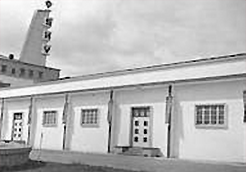
Lido, Singapore
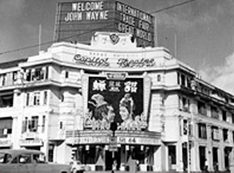
Capitol, Singapore
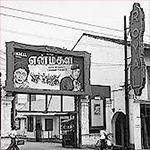
Royal, Singapore
The Shaw chinese films would be showcased for a couple of days at the Capitol before starting their season at the Chinese language halls.
Likewise, a Shaw Malay film might be premiered at Rex before its season run at Queen during the heyday of Shaw Malay productions.
After first-run halls, a film booked into second-run halls. Of these, Roxy (later converted to a first run Chinese film hall in the 1970s), State and Globe would play English language films while Atlantic, Ciros, Pacific, Canton, Empire and Sun second-run Chinese shows. With the occasional oversupply of first-run English language films, State and Globe could be converted into first-run halls.
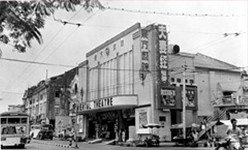
Oriental, Singapore
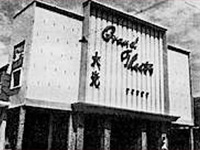
Grand, Singapore
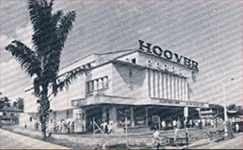
Hoover, Singapore
For Indian second-run films, Canberra and Ciros were the venue. Canberra, located near the British Naval Base in Sembawang catered to the Indian workers there. Ciros, located at Keppel port mainly catered to Indian dock hands as well.
As a mixed product hall, Ciros played Indian, Chinese as well as third-run English films. Another mixed product hall was Queen which became a second-run hall for both English and Chinese language product after the demise of Shaw's Malay productions in the late 60s.
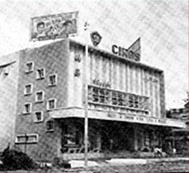
Ciros, Singapore
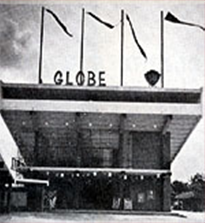
Globe, Singapore
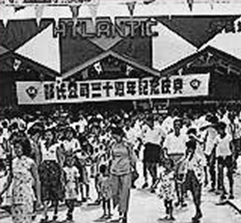
Atlantic, Singapore
Second-run halls were often less 'modern' than first-run halls but what they lacked in comfort they made it up in economy. Admission prices for a second-run hall like the Roxy was $1.80, $1.20, 80 cents and 40 cents and played 3-4 shows a day. Second-run cinemas like Atlantic, Canton, Empire and Sun were constructed mainly of wood and patrons sat on hard benches (These were later replaced by plywood chairs handed down from the first-run halls). On both sides were bamboo curtains that would be raised at night for ventilation. A chain fence surrounded the cinema, so bystanders could not watch the movie along the exposed sides. Ceiling fans complimented the evening breeze.
Third-run english language films played at the Ciros and Naval Base cinemas. Halls such as Atlantic, Pacific, Canton, Empire and Sun played third-run Chinese movies as well as their usual second-run fare. Admission rate was the same as for second-run movies.
'Double billing' was an occasional practice at second and third run halls. This was where a single session consisted of two films screened back to back. Usually, a newer, bigger budget film would be paired with an older film. Some of the second bills were sequels to the first. In the 1970s, this practice was brought back for a limited time only for James Bond releases which would be paired with an older Bond film.
'Matinees' are films that have already played the first through third-run circuit but have been brought back to first-run halls due to its continuous popularity. These were a bargain at 50 cents for stall and $1 for circle. They were shown Sunday mornings between 8.30 and 9 am. Cheap matinees like Tarzan-Lord of the Apes starring Johnny Westmuller and featuring Rock and Roll brought back crowds even as late as the 1970s. But with the advent of video in the early 1980s, second and third-run films could be watched at home so second or third-run halls gradually lost their popularity.
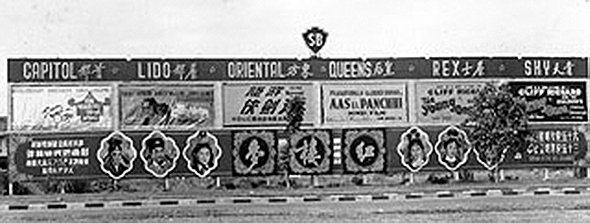
Billboard, Singapore, 1962
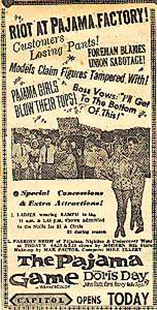
"Free admission for couples in pajamas!" Promotion for 'The Pajama Game', a 1958 movie which starred Doris Day.
Smoking was allowed in all classes and all halls. Non-smokers had to put up with cigar, cheroot and cigarette smoke which were especially heavy in halls not equipped with exhaust fans. On 21 March 1954, the Pavilion cinema in Singapore was the first to begin banning smoking in cinemas. Although non-smokers applauded the effort, smokers made the issue front page news. Complaints ranged from discomfort to lethargy. Some suggested banning the noisy consumption of peanuts and water melon seeds instead. This debate was to rage on for more than a decade until smoking was completely banned in cinemas.
Prices remained relatively stable until the mid-70s. At that time, prices for first-run english language halls were adjusted to $3.50 for circle, $2.50 for back stall and $1.50 for front stall.
Ticket prices were revised again in 1981 when front stall seats were scrapped of their $1.50 and merged with back stall seats with a price of $2.50. On 28 May 1987, ticket prices for stall seats went from $2.50 to $3 and circle seats from $3.50 to $4. By 1988, the first cineplex were opened with admissions at $3.50.
On 19 January 1991 there was another price revision. Prices for cineplexes went up to $4, while single screen halls had prices boosted by 50 cents. At this time, Jade Classics charged $6 for quality art-house movies. In 1993, prices for cineplexes jumped to $6 while single screen hall prices were $5 and $6 for stall and circle respectively. Art-house films went up to $8. By 1995, all theatres had a uniform price of $6. This single-price was to go up to $7 on 25 April 1996.
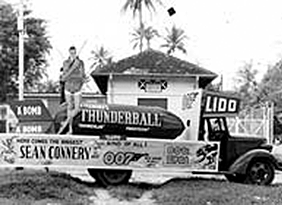
Sir Run Run and Tan Sri Runme Shaw in their office
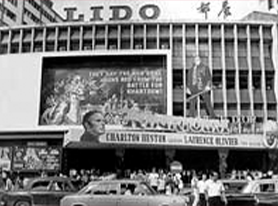
Orchard Road, Singapore 1925
There would be no further changes for another 3 years until the economic crisis compelled the exhibitors association (CFEA) to grant a $5 special Tuesday price. The success of this special price eventually led to the differential price structure for movie tickets implimented on 4 February 2000.
Most weekdays were fixed at $5 (at sessions before 5 pm) and weekends at $8.
This change was to make cinema going even more affordable to a bigger segment of society especially students, families and senior citizens who tend to patronise before 5 pm sessions and on weekdays.
Currently, the ticket prices have been adjusted to $6.50 from Mondays - Thursdays, $7.50 for Thurday's opening films and $8.50 for the weekends, starting from Friday 5 pm shows. (For detailed current rates, please check out cinemas page.)













